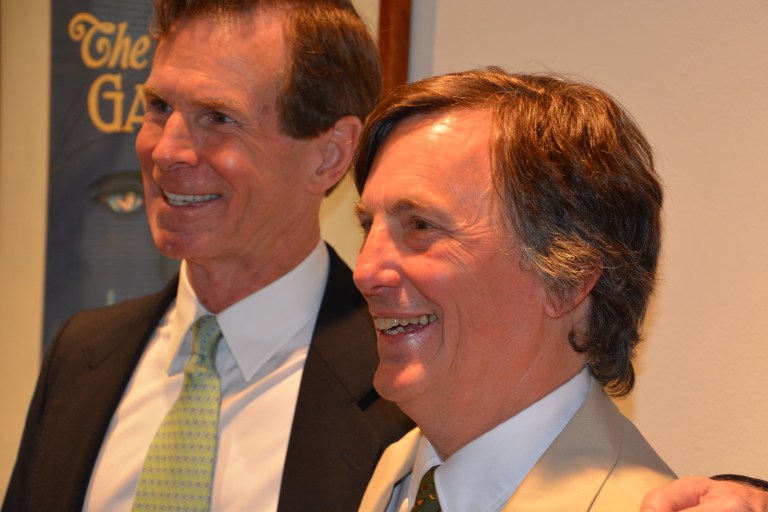
At long last the humanities have come to Long Island.
They arrived in the guise of Charles Scribner III who is a well-known classical scholar, Princeton graduate and publishing giant.
Now that’s what I call a Renaissance man. The Nassau County Museum of Art has outdone itself this time by putting together a blockbuster series entitled “Anything Goes: the Jazz Age.”
When I heard about the show I got my ticket and arrived at the museum just at 3 p.m. thinking that the talk would be sparsely attended. I could not have been more wrong.
In fact the talk was essentially sold out and filled their upstairs conference room to overflowing.
I think what attracted the crowd was both the name of Charles Scribner III who is a true luminary in his own right and that he would be talking about the life of F. Scott Fitzgerald and his literary classic “The Great Gatsby.”
Let me briefly give you a definition of the humanities in order to prepare you for what I learned from Mr. Scribner.
The humanities, in contrast with the natural sciences, takes us into the study of literature, art, music and philosophy.
The reason the humanities is so crucial today is that it reminds us what it’s like to be human.
So much of our post-modern life is machine driven that in very short order we will be more cyborg than human. This is why Mr. Scribner drew a full house.
We all want to remain human just a little while longer and what better way than to listen to an expert on Fitzgerald chat about the writing of an American classic about life on Long Island.
And make no mistake, “The Great Gatsby” is a true American classic, taught in every high school and college and translated into 42 languages worldwide.
I do not have room to touch upon every point Scribner tried to make but here are a few gems for you to chew on.
1. The creation of the book jacket by Francis Cugat was so perfectly rendered that upon its completion it impressed Fitzgerald so much that he redid parts of the book in order to include the images on the cover. The image of two beautiful eyes and those red lips over a blue skyline is now considered the most celebrated piece of art in American literature and the original artwork is on display in the museum.
2. Fitzgerald changed the title many times including “The High Bouncing Lover” and “Trimalchio in West Egg.” Thanks to the good sense of Scribners, the original title remained as is.
3. There have been four full length films based upon the book with the most famous being with Robert Redford and Mia Farrow. I still remember the scene when Gatsby showed Daisy the gorgeous London shirts he had stockpiled away and her Stendhal-like reaction to their beauty.
The costumes in this film were all designed by Ralph Lauren which established his career as a fashion icon.
4. When “The Great Gatsby” was first published in 1925 it sold poorly.
It was only when America emerged from the Great Depression and WWII twenty five years later that this work began to gain popularity. So for all you budding young writers who wish to write the next great American novel, do not lose faith.
5. I was able to ask Charles Scribner what he considered to be the magic ingredients of a great novel. He paused for a moment, then smiled and said “I would say all great novels must have three essential elements.
They must first of all have characters that engage the reader and get you to care about them. Then you must have a plot that moves and draws you along with it. And finally you must have lyricism in the book.
So often today’s novelists lack lyricism or joy. They don’t sing to you but instead tend to yell at you”.
6. Maybe my favorite moment came when he gave a quote from Oscar Wilde, which was “Life imitates Art far more than Art imitates Life. What is found in life is not what is really there but is that which the artist taught people to find there, through art.”
I believe this and that’s why I spend much of my spare time reading the literary masterpieces before I travel overseas.
Before going to Hawaii I read Michener’s Hawaii and so before I even arrived I knew how look at the waves crashing on Diamond Head.
Before going to Rome I read Nathaniel Hawthorne’s “The Marble Fawn” and it was the best travelogue you could ever find about the secrets of Rome. And you can only truly appreciate the Tuileries Garden in Paris after reading Proust’s “Remembrance of Things Past.”
Wilde is right when he says the great writers teach us how to see the world and its true beauty.
So thank you Charles Scribner III, thank you Dr. Charles A. Riley and thank you Nassau County Museum of Art for bringing some magic and some humanity back to a community that is hungry for it.
The magic of great art is just like that green light across the bay that Jay Gatsby would always stretch out to reach.
We’re all like Jay Gatsby in that way, all looking for some beauty and some solace and for a way to be saved. So I guess I should thank F. Scott Fitzgerald too.
He died too young but he sure did leave us a sweet gift.








This is not just superb reportage (catching these quotes on the fly during a lecture so fast-moving it was a thrill ride) but a thoughtful, almost sad commentary on the state of the humanities locally.
Deeply appreciated by all of us here at the Nassau Museum where we wage this battle with creeping indifference to art, literature and music every day
Bravissimo
Charles Riley
Director